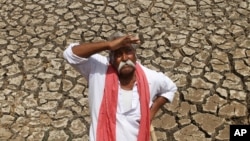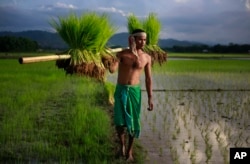For many farmers in Nepal, the Indian state of Sikkim and the kingdom of Bhutan, disaster struck on October 23 when an intense hailstorm destroyed their rice, millet and other crops.
Adequate relief from governments is unlikely and most do not have insurance.
It is a calamity frequently experienced by small farmers throughout the developing word.
"They are totally exposed," said Mahfuzuddin Ahmed, the adviser for rural development, food security and agriculture at the Asian Development Bank. "They need to be able to get up on their feet again for the next crop."
Nongovernmental organizations have been devising insurance schemes to help such farmers. But promoters found initial difficulty marketing them.
"We were very naive. In the beginning, we really thought that farmers would buy insurance," recalled Pula Advisors director Rose Goslinga in Nairobi.
"People didn't trust it. People thought, 'I'm going to wait and see what happens. I'm not sure if I need it this year.' They'd look at the sky: 'There's going to be rain so I don't need to buy it this year,'" she told VOA.
"If you look at the U.S., the U.K. and Europe, all of these kind of crop insurance products are actually subsidized by the government," said Richard Leftley, chief executive officer of MicroEnsure.
But when governments in countries notorious for a lack of transparency get involved, the full insurance payouts frequently do not reach the intended beneficiaries.
"It could be corruption because the money changes hands by the time it reaches the actual beneficiary. There could be a lot of hurdles in between along the way," acknowledged Mahfuzuddin.
Thus "farmers suffer more than they should," added Pramod Aggarwal, a regional director for the Consultative Group for International Agricultural Research.
And the insurance has been priced too high even for those farmers who want to purchase it.
"The product may cost 10 percent, plus distribution costs. It might cost $12 to buy a product that would pay out $100 in the event of a bad harvest. But the farmers are only really willing to pay somewhere in the region of three to five dollars for that product. That's been our experience," said Leftley, whose company has 15 million customers in 17 African and Asian countries, but less than 1 percent of its business is agriculture insurance.
A breakthrough came by marketing crop insurance as a bundled product through entities that serve farmers.
"Banks that are looking to lend to agriculture. Seed companies, fertilizer companies. If it doesn't rain, they don't sell any seed or fertilizer," explained Goslinga.
In India, 30 million farmers now have insurance. But the flip side of that success is 80 percent of India's farmers still have no such coverage.
Meanwhile, in Africa farmers are becoming astute as they move beyond subsistence levels and acquire investments in their soil, seeds and crops.
The Kilimo Salama model, funded by the Global Index Insurance Facility and the Syngenta Foundation, where Goslinga previously worked, has provided insurance to about 200,000 farmers in east Africa, mainly in Kenya, Rwanda and Tanzania.
The model expanded into Ethiopia this year and is expected to launch next year in Ghana and Uganda.
"As agriculture in Africa becomes more business oriented, becomes profitable, we're seeing people pick up things like insurance, as well," said Goslinga.
As mobile phones get into the hands of even the most remote farmers, reliable electronic payouts are becoming more common, giving policyholders additional assurance.
Because it is so expensive to verify losses on large numbers of small landholdings, the traditional type of individual loss-based insurance is not always viable. That has led to index-based insurance for smallholder farmers for weather-related risks.
"Traditionally, insurance would look at what the yield was and then it wouldn't differentiate between whether it was from locusts, from hail or too much rainfall. It would cover all of those," explained Leftley. "These index products the disadvantage is that they can only really pay out for specific events for which an index can be measured remotely like rainfall or wind speed."
Thus, it cannot gauge the damage, for example, caused by the October 23 Himalayan hailstorm, a relatively rare type of risk to South Asian farmers until recently.
"So we don't have relatively well-developed hailstorm insurance. This is something that is worrying farmers a lot," said Aggarwal in New Delhi.
Climate change is forecast to make weather variables more extreme. Rising temperatures will eventually alter growing conditions. That will mean opportunities for better or different crops for some farmers, while others will find their land unsustainable for what they have traditionally grown.
Traditional farming has always been risky, but "it's becoming riskier now because of the increasing climatic unpredictability. For that matter, even irrigated agriculture is also coming under stress because of issues like hailstorms, extreme rainfall or high temperature,” explained Aggarwal.
Farmers need to acquire more knowledge about the likely consequences in their region and band together to protect their common interest, advised ADB's Mahfuzuddin in Manila.
"An individual may not be as powerful. But as an association or a producer group, I think they have some power on acquiring knowledge and using this knowledge to influence the policy," he added.
Insurance needs to be regarded as just one aspect in the risk management portfolio, said Aggarwal.
"What insurance does helps farmers in providing some sort of a safety net," he explained. "But it does not necessarily lead to increasing production or stability in production."
In the long run in the developing world, specialists argue, what is needed most is investment in science and technology to give farmers the 21st century tools they need to adjust to the challenges posed by climate change.












